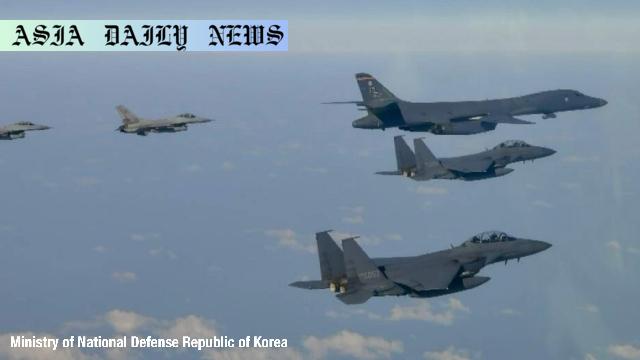US B-1B bomber takes part in South Korea-US joint air drills to counter North Korea’s nuclear and missile threats.
– South Korea and the US performed joint air exercises over the Korean Peninsula.
– The drills involved at least one US B-1B bomber and fighter jets from both nations.
– The exercises aimed to strengthen extended deterrence against North Korea’s nuclear and missile threats.
– The drills also emphasized enhancing operational cooperation between allies.
– South Korea’s defense ministry pledged to continue expanding combined air exercises.

Introduction: Strengthening Allied Cooperation
South Korea and the United States recently conducted joint air exercises as a decisive step to reinforce their defense capability amidst rising security threats from North Korea. The air drills featured at least one US B-1B bomber, a supersonic aircraft capable of deploying a range of weaponry effectively. Fighter jets from both nations also participated, further demonstrating the operational solidarity between the two allies.
The Role of the B-1B Bomber
The US B-1B bomber played a crucial role in this exercise. This long-range, heavy bomber boasts exceptional speed, allowing it to reach the Korean Peninsula within two hours from its base in Guam. Known for its superior load capacity and precision targeting, the B-1B serves as a critical deterrence tool for potential threats from North Korea, which continues to develop its nuclear and missile programs aggressively.
Extended Deterrence Against North Korean Threats
South Korea’s Ministry of Defense highlighted the strategic importance of the drills in countering North Korea’s provocations. With its nuclear and missile ambitions escalating in recent years, North Korea remains a major security concern for the region. These joint exercises not only send a powerful message to Pyongyang about the strength of the South Korea-US alliance but also underscore the US’s commitment to defending its allies.
Operational and Tactical Coordination
The interoperability between South Korean and US forces was a core focus of the drills. Both nations aimed to fine-tune their operational tactics and communication systems to prepare for potential real-world scenarios. By conducting such exercises, South Korea and the US strive to fortify their joint military readiness, ensuring swift and coordinated responses to any emergencies.
Commitment to Expanding Drills
A notable feature of the training was the emphasis on continuous cooperation and expansion of combined exercises. South Korea’s defense ministry stated that the partnership aims to deepen strategic coordination to counter evolving security challenges. As North Korea shows growing boldness in its missile tests, the two allies plan to enhance their joint drills, incorporating advanced technologies and combat strategies.
A Broader Message
Beyond immediate military preparedness, the drills carry an underlying diplomatic significance. They serve as a testament to the enduring alliance between South Korea and the United States. In a time when global dynamics often challenge bilateral relations, these exercises symbolize a steadfast partnership focused on peace and stability in the region.
Conclusion
South Korea and the United States remain resolute in their efforts to deter threats and maintain regional stability through enhanced military cooperation. The recent joint air drills, featuring the formidable US B-1B bomber, underscore their commitment to mutual defense and their readiness to respond to any provocation. These efforts not only bolster their partnership but also ensure a unified stand against escalating threats emerging from North Korea’s growing militarization.
Commentary
The Importance of Strategic Military Exercises
The joint air drills conducted by South Korea and the US highlight an essential component of regional security—strengthening allied cooperation to deter potential aggressions. In a world where geopolitical tensions are rising, the value of projecting power and unity cannot be underestimated. These exercises remind us of the importance of preparedness and collaboration in maintaining stability.
A Strong Message to North Korea
The inclusion of powerful military assets like the US B-1B bomber undoubtedly sends a strong message to North Korea. By demonstrating their rapid response capabilities and operational synergies, South Korea and the US aim to reaffirm their commitment to countering any threats posed by Pyongyang. It places clear emphasis on their no-tolerance stance for nuclear or missile provocations.
Broader Implications for Alliances
This exercise not only reinforces military ties but also strengthens diplomatic confidence between Washington and Seoul. Such collaboration underscores the unyielding nature of their alliance in the face of adversities. For South Korea, it bolsters national security, while the US gains by maintaining a proactive presence in a strategically significant region.
Final Thoughts
The expanded scope of these drills reflects a broader commitment to evolving strategies and technologies. As challenges from North Korea intensify, such exercises will likely remain a cornerstone of South Korea-US defense cooperation. It’s imperative that such efforts continue to ensure peace and stability in the Asia-Pacific region, setting a precedent for other global partnerships.


